UPU PERIOD - Postal Cards :::
|
 Back to UPU Period. Back to UPU Period.
|
"Postal cards" are those issued by a postal authority and pre-printed with a value. See Postal Cards and Post Cards. "Post Cards" are the kind purchased at a stationery store to which a stamp must be affixed. Postal cards were first used in Hawaii in March, 1882. All of Hawaii's standard postal cards are found in the foreign mail, but I have not tracked the message and reply cards to say whether all of them are found in the foreign mail.
Foreign Postal Card Rates To 1885
Rates for postal cards varied according to the destination. See Mail Rates. Throughout the UPU Period, the postal card rate to destinations in North America was 2¢. Notwithstanding the apparent lack of sanction from the UPU, Hawaii charged 3¢ to send a postal card to Europe or other UPU member countries beyond North America, except Japan, UPU ports in China, Straits Settlement (Singapore) and Manila, to which the 2¢ rate was made applicable. The 3¢ rate ended sometime in 1885, following the UPU Conference that year. Postal cards to the Australasian Colonies cost 3¢ until those Colonies joined the UPU on October 1, 1891. Thereafter, the number of destinations to which the 3¢ postal card rate applied was very small but did include Samoa and Fiji. No postal cards to those destinations are included in my record.
To North America and East Asian Ports
|
|
|
Postmarked June 15, 1882 at Honolulu and addressed to Boston, this 2¢ UX2 postal card shows the 2¢ postal card rate to destinations in North America, including Canada and Mexico.
|
|
|
Another example of the 2¢ rate to North America, this 2¢ UX2 postal card was postmarked November 1, 1884.
To Europe and Other UPU Destinations Beyond North America, Exept East UPU Asian Ports
|
|
|
Postmarked July 2, 1882, this 3¢ UX3 postal card shows the 3¢ rate to Europe in force from Hawaii until mid-1885. Debate has surrounded the 3¢ card because there was no apparent authority under the UPU for a 3¢ rate. Nonetheless, Hawaii believed the terms of its entry allowed it to charge a 3¢ rate and its published rates reflected that belief. That belief held until sometime in 1885, when it was reduced to 2¢ to all UPU countries, but the 3¢ rate was retained for postal cards to Australasia, including Fiji and Samoa when sent direct by the New Zealand mail. Exactly why the 3¢ rate to UPU countries existed, and why it was changed in 1885, is unclear. However, at the UPU Convention in 1885, currency equivalencies were adjusted and I suspect the answer lies somewhere in those adjustments. A search of post office notices and correspondence has failed to unravel this mystery. The fact of the rate and the change is seen in the postal cards used at the time. Please E-mail (scott312@earthlink.net) me with any information on why the 3¢ rate was allowed or why it was terminated.
|
|
|
Postmarked April 7, 1882, this UX3 is the current EKU for this postal card. It paid the then current 3¢ rate to Madeira and was carried via London.
|
|
|
Postmarked July 14 at Honolulu and August 7, 1884, at London, this card is another example of the 3¢ rate to Europe. I record numerous European destinations for the UX3 cards while this rate was in effect. The latest I record before the 2¢ rate was in effect is December 21, 1884. Use of the 3¢ UX3 continued after mid-1885 as an overpayment of the rate. People were probably using up cards they had purchased earlier.
Foreign Postal Card Rates After Mid-1885
Europe
|
|
|
Postmarked September 30, 1885, the 2¢ UX2 postal card is the earliest example I have found to show the new 2¢ rate to Europe was in effect.
|
|
|
Postmarked November 21, 1891 and sent to Budapest, Hungary, this 2¢ UX2 postal card is another example of the 2¢ rate to Europe.
|
|
|
Look at this transit time! Postmarked October 25, 1892, this 2¢ UX2 postal card was postmarked November 10 at San Francisco and November 15 at St. Petersburg, Russia. How could this be? Lucky connections cannot explain a 5 day transit period between San Francisco and St. Petersburg. What needs to be remembered is in 1892 Russia was still using the Julian Calendar and in that year one must add twelve days to the Gregorian date. So November 15 in Russia was November 27 in Hawaii.
|
|
|
This UX6 postal card sent to Wales originated at Waimea, Kauai, and was postmarked there on September 16, 1893 with Waimea type 282.011 and at Honolulu on September 17. The overprinted cards initially were sold to speculators who later sold some for use. This card is a philatelic use.
|
|
|
Postmarked July 16, 1895 and sent to Sweden, this use of the overprinted UX7 may be philatelic as it is overpaid 3¢. However, there is a mysterious rate confusion about this time reflected in Taxed Letters and Cards.
Australasia
|
|
|
Postmarked January 11, 1889 and addressed to New Zealand, this 1¢ UX1 franked with an additional 2¢ Scott No. 43 shows the 3¢ postal card rate to Australia in effect until the Australasian Colonies joined the UPU on October 1, 1891.
|
|
|
Postmarked March 12, 1896 on a UX9 postal card to New Zealand. This card was charged the correct 2¢ rate in effect after New Zealand joined the UPU on October 1, 1891.
North America
|
|
|
Postmarked January 18, 1893 at Honolulu, this 2¢ UX2a postal card was mailed the day following the Hawaiian Revolution and was sent on the first mail bag after the Revolution. This card shows the normal 2¢ rate. The message refers to martial law imposed in Honolulu.
Asia
|
|
|
Postmarked November 12, 1887 at Lihue, Kauai with Lihue type 253.41 and at Honolulu on November 13 with Honolulu type 235.22, this 3¢ UX3 card overpaid the 2¢ rate to Bombay, a part of British India belonging to the UPU. The card was marked on December 22, 1887 with a Bombay Sea Post Office date stamp (Kirk type 4; see Bibliography below) in the upper left corner.
|
|
|
Originating at Koloa, Kauai and postmarked there on November 18, 1892 with Koloa type 251.02, and at Honolulu later in November (the date is indistinct), this UX2 card paid the 2¢ rate to Hong Kong, in effect after mid-1885.
|
|
|
Postmarked October 2, 1895, this UX5 postal card is one of a set of each overprinted value sent to the same addressee on this date. It pays the correct rate of 2¢ and picked up a Bombay Sea Post Office mark on November 5 (Kirk type 7, set A).
|
|
|
Postmarked January 7, 1897 this 1¢ UX8 postal card was sent to Japan and shows the 2¢ rate to that country.
|
|
|
Postmarked August 15, 1899 on a UX9a postal card and sent to Japan at the 2¢ rate. This card originated at Honouliuli on the island of Oahu and was postmarked there on August 12, 1899.
Other Destinations
|
|
|
Postmarked August 25, 1888 and sent to Jamaica, a member of the UPU, this UX3 card merely shows a 1¢ overpayment of the 2¢ rate.
Around The World Postal Card
|
|
|
|
|
Front and back of a German postal card sent around the world, a popular philatelic exercise in the late 19th Century. The idea was to send a postal card to someone who would forward it to someone else farther along the journey in the hope the cover eventually would be returned to the sender after going around the world. This card transited Honolulu where it was franked with the 2¢ brown Scott No. 75 and postmarked on May 10, 1894 and May 12, 1894. The postal card appears to have succeeded in completing its around the world trip, picking up postmarks in such places as Suez, Batavia, Samarang, San Francisco, Savannah and New York.
BIBLIOGRAPHY
Kirk, R., British Maritime Postal History, 2 vols., Postal History International, Proud-Bailey Company, Ltd., Dereham, England, circa 1980-1981. Emphasis is on British mail via Suez to Australia and the Far East but significant for illustration of Bombay Sea Post Office postmarks (Vol. 1, p. 14-25) found on Hawaiian origin mail and for its extensive listing of sailing tables for the P&O Line.
|

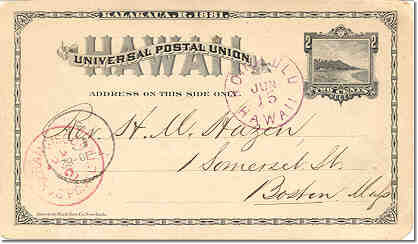


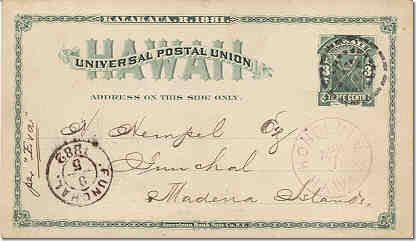
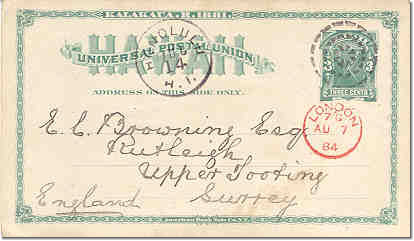
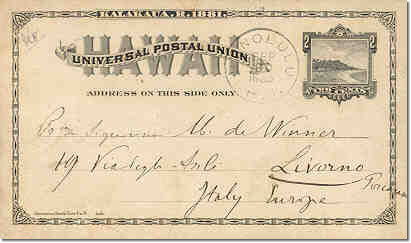
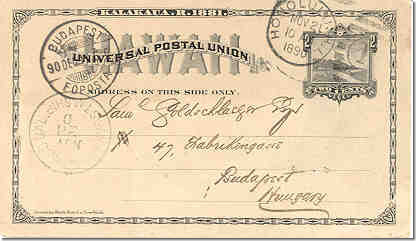

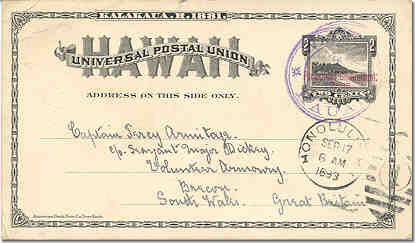
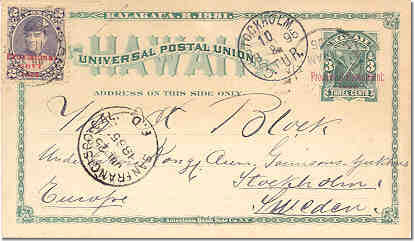







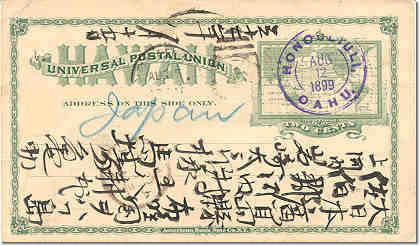
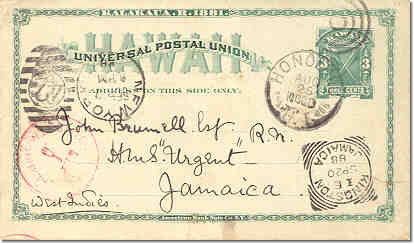


Replies
Mahealani Asing Kahau would have answers to this.........
The Postal Treaty is still in place.
Thanks for reminding us of this because there are many ongoing issues.